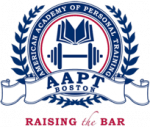Top 4 Benefits of a Hands On Training Education
Picture this: you’re interviewing heart surgeons for an upcoming surgery. You ask the surgeon about their qualifications. They confidently reply, “Well, I watched a bunch of youtube videos on surgery…and I look really good holding a scalpel.”
This is what the world of personal training is like.
I often tell the class at AAPT that the Personal Training field is like the wild west. There are no state or national standards as to who can call themself a personal trainer. Consequently you have a wide variety in the quality of fitness professionals. Some have masters degrees in kinesiology while others have nice arms and “researched” some cool moves on instagram.
With no professional credentials required, how does someone become a good trainer who can consistently get their clients results in a safe, efficient and effective manner?
Just like how you’d want your heart surgeon to have a comprehensive classroom education, hands on training and a high success rate, a successful trainer should have the same. This brings me to the:
Top 4 Benefits of a Hands On Training Education
1. Know exactly how to train your first paying client
I trained my first paying client in 2007 at a Bally Total Fitness. I had studied the CSCS textbook thoroughly and passed the exam without much trouble. The one thing I hadn’t done was take an actual person through a training session! Sure, I knew what a sarcomere was, but the 56 year old woman who hired me didn’t care about that. I’d done some tough strength training as an active 24 year old, but my client wasn’t going to be banging out sets of 10 chin-ups and pistol squats. I was completely unprepared to train anyone other than myself.
I didn’t know how to properly assess her.
I couldn’t scale exercises to fit her needs.
I didn’t know how to progress her through a 3 month program.
I failed her as a trainer (sorry Doris).
It took me a long time to course correct and figure out how to properly train gen pop clients. Now, 16 years later, I tell the class that our 12 week hands on program will fast forward their career by 2-3 years.
We make our mistakes in the classroom so we can have the answers on the job. With a dozen or so classmates there are ample opportunities to
- Build a vast exercise library
- Learn how to scale an exercises for different bodies and capabilities
- Design an air tight session and a long term goal driven program
In other words, they can hit the ground running with their clients.
2. Learn the Business of Training
What are the most effective marketing methods? How do you talk about your business to a potential client? How can you build rapport with them during the intake session? These are skills that could be the difference between struggling to make a buck or having a thriving lucrative business with no shortage of clients.
The good news is that these are skills you can learn and improve upon with practice. Find the most effective ways of marketing your services beyond social media. Practice your sales pitch with classmates so it rolls off the tongue instead of sounding like a bad used car salesman. Taking a deep dive with our clients to find what is motivating them towards their goal.
Knowing the right exercise for your client is a must, but first we have to get a client in the door!
3. Build a Local Fitness Network
Even in a big city, the fitness community is a small world. Everyone seems to know everyone else in the training biz. Personally, each job I’ve had in Boston as a trainer or fitness educator I’ve found through word of mouth and been hired largely due to personal references. A huge benefit of attending a hands-on program is that the school’s network becomes the student’s network. Job placement goes from endlessly submitting resume’s online to getting in person introductions to gyms and facilities in the area that are looking to hire trainers right after graduation.
4. Camaraderie
Anyone who’s been on a successful team knows that there is a special kind of energy that is difficult to explain when the group comes together. As Aristotle would say, the whole is greater than the sum of its parts. I find this to be as true in the classroom as it is on the field of play. A group of like minded students can learn more, at a faster rate than the solitary individual reading a textbook at home.
In the classroom there are more people to bounce ideas off of. Questions arise that you may never have thought of on your own. Study partners are not only plentiful, but diverse. A classmate may have a unique perspective that might make a topic ‘click’ for you in a way that the textbook couldn’t.
You may be thinking “Mark, aren’t you pretty biased here considering you teach the class?” Perhaps, dear reader, but remember I was the new trainer who struggled for a long time because I only learned from the textbook and didn’t have the benefit of a hands on program. One of the main reasons I took the teaching position is because I know how beneficial it is to the careers of the students.
In the wilderness of personal training you can be a lone wolf…but you’ll eat better and more often when you run with a solid pack.




